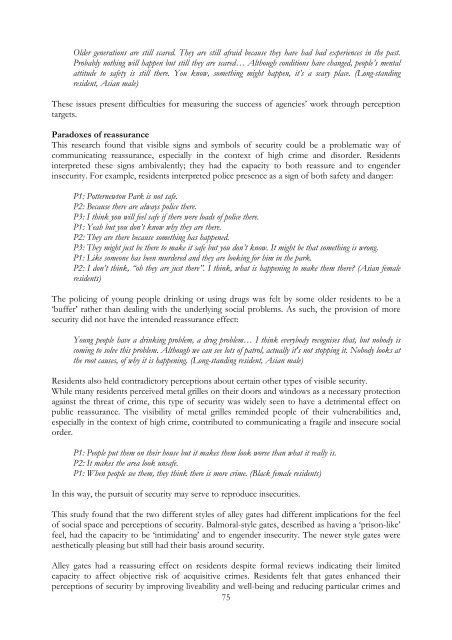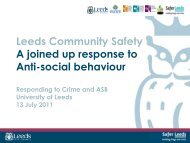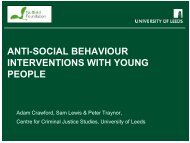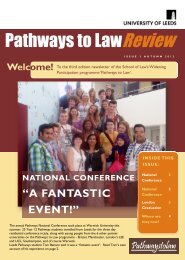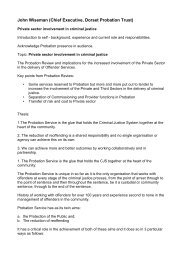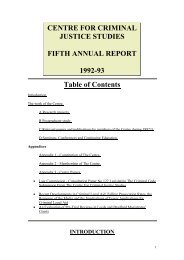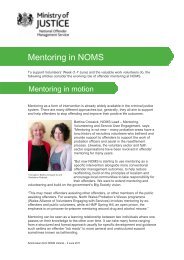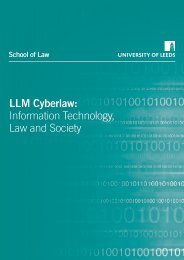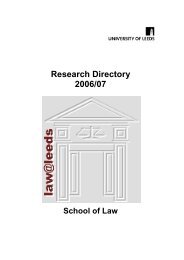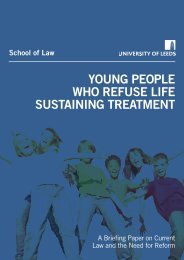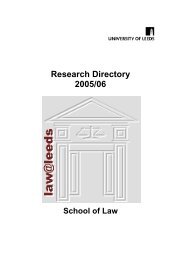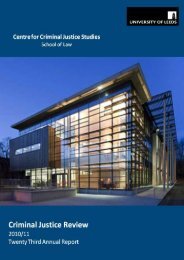Older gener<strong>at</strong>ions are still scared. They are still afraid because <strong>the</strong>y have had bad experiences in <strong>the</strong> past.Probably nothing will happen but still <strong>the</strong>y are scared… Although conditions have changed, people’s mental<strong>at</strong>titude to safety is still <strong>the</strong>re. You know, something might happen, it’s a scary place. (Long-st<strong>and</strong>ingresident, Asian male)These issues present difficulties for measuring <strong>the</strong> success <strong>of</strong> agencies’ work through perceptiontargets.Paradoxes <strong>of</strong> reassuranceThis research found th<strong>at</strong> visible signs <strong>and</strong> symbols <strong>of</strong> security could be a problem<strong>at</strong>ic way <strong>of</strong>communic<strong>at</strong>ing reassurance, especially in <strong>the</strong> context <strong>of</strong> high crime <strong>and</strong> disorder. Residentsinterpreted <strong>the</strong>se signs ambivalently; <strong>the</strong>y had <strong>the</strong> capacity to both reassure <strong>and</strong> to engenderinsecurity. For example, residents interpreted police presence as a sign <strong>of</strong> both safety <strong>and</strong> danger:P1: Potternewton Park is not safe.P2: Because <strong>the</strong>re are always police <strong>the</strong>re.P3: I think you will feel safe if <strong>the</strong>re were loads <strong>of</strong> police <strong>the</strong>re.P1: Yeah but you don’t know why <strong>the</strong>y are <strong>the</strong>re.P2: They are <strong>the</strong>re because something has happened.P3: They might just be <strong>the</strong>re to make it safe but you don’t know. It might be th<strong>at</strong> something is wrong.P1: Like someone has been murdered <strong>and</strong> <strong>the</strong>y are looking for him in <strong>the</strong> park.P2: I don’t think, “oh <strong>the</strong>y are just <strong>the</strong>re”. I think, wh<strong>at</strong> is happening to make <strong>the</strong>m <strong>the</strong>re? (Asian femaleresidents)The policing <strong>of</strong> young people drinking or using drugs was felt by some older residents to be a‘buffer’ r<strong>at</strong>her than dealing with <strong>the</strong> underlying social problems. As such, <strong>the</strong> provision <strong>of</strong> moresecurity did not have <strong>the</strong> intended reassurance effect:Young people have a drinking problem, a drug problem… I think everybody recognises th<strong>at</strong>, but nobody iscoming to solve this problem. Although we can see lots <strong>of</strong> p<strong>at</strong>rol, actually it's not stopping it. Nobody looks <strong>at</strong><strong>the</strong> root causes, <strong>of</strong> why it is happening. (Long-st<strong>and</strong>ing resident, Asian male)Residents also held contradictory perceptions about certain o<strong>the</strong>r types <strong>of</strong> visible security.While many residents perceived metal grilles on <strong>the</strong>ir doors <strong>and</strong> windows as a necessary protectionagainst <strong>the</strong> thre<strong>at</strong> <strong>of</strong> crime, this type <strong>of</strong> security was widely seen to have a detrimental effect onpublic reassurance. The visibility <strong>of</strong> metal grilles reminded people <strong>of</strong> <strong>the</strong>ir vulnerabilities <strong>and</strong>,especially in <strong>the</strong> context <strong>of</strong> high crime, contributed to communic<strong>at</strong>ing a fragile <strong>and</strong> insecure socialorder.P1: People put <strong>the</strong>m on <strong>the</strong>ir house but it makes <strong>the</strong>m look worse than wh<strong>at</strong> it really is.P2: It makes <strong>the</strong> area look unsafe.P1: When people see <strong>the</strong>m, <strong>the</strong>y think <strong>the</strong>re is more crime. (Black female residents)In this way, <strong>the</strong> pursuit <strong>of</strong> security may serve to reproduce insecurities.This study found th<strong>at</strong> <strong>the</strong> two different styles <strong>of</strong> alley g<strong>at</strong>es had different implic<strong>at</strong>ions for <strong>the</strong> feel<strong>of</strong> social space <strong>and</strong> perceptions <strong>of</strong> security. Balmoral-style g<strong>at</strong>es, described as having a ‘prison-like’feel, had <strong>the</strong> capacity to be ‘intimid<strong>at</strong>ing’ <strong>and</strong> to engender insecurity. The newer style g<strong>at</strong>es wereaes<strong>the</strong>tically pleasing but still had <strong>the</strong>ir basis around security.Alley g<strong>at</strong>es had a reassuring effect on residents despite formal reviews indic<strong>at</strong>ing <strong>the</strong>ir limitedcapacity to affect objective risk <strong>of</strong> acquisitive crimes. Residents felt th<strong>at</strong> g<strong>at</strong>es enhanced <strong>the</strong>irperceptions <strong>of</strong> security by improving liveability <strong>and</strong> well-being <strong>and</strong> reducing particular crimes <strong>and</strong>75
disorders th<strong>at</strong> m<strong>at</strong>tered to <strong>the</strong>m (e.g. drug dealing, joy riding <strong>and</strong> nuisance noise). By increasingcontrol <strong>and</strong> ownership <strong>of</strong> back streets, residents suggested th<strong>at</strong> <strong>the</strong> g<strong>at</strong>es stimul<strong>at</strong>ed protectiveneighbouring <strong>and</strong> positive rel<strong>at</strong>ionships. These aspects <strong>of</strong> alleyg<strong>at</strong>ing produced a positivecommunic<strong>at</strong>ion effect amongst residents <strong>of</strong> <strong>the</strong> areas.However, implemented under a crime reduction agenda, <strong>the</strong>re was a danger th<strong>at</strong> g<strong>at</strong>ing becameassoci<strong>at</strong>ed with ‘bad streets’ despite <strong>the</strong> improvements <strong>the</strong>y fostered. Fur<strong>the</strong>rmore, many residentsexpressed concern about wh<strong>at</strong> visible security hardware signified about <strong>the</strong>ir area <strong>and</strong> identifiedimplic<strong>at</strong>ions for neighbourhood stigm<strong>at</strong>is<strong>at</strong>ion:Everybody thinks robbers come from Beeston; <strong>the</strong>y must think this is a bad area, th<strong>at</strong>’s why bars <strong>and</strong> g<strong>at</strong>esare needed. (Asian male resident)These paradoxes <strong>of</strong> reassurance show th<strong>at</strong> <strong>the</strong> mechanisms agencies use to provide security <strong>and</strong>communic<strong>at</strong>e reassurance are equally important in shaping perceptions as ‘how much’ security<strong>the</strong>y provide. On an informal level, while young people derived reassurance <strong>and</strong> a sense <strong>of</strong> safetyfrom being toge<strong>the</strong>r, this engendered insecurity for o<strong>the</strong>r residents.I feel safer when I am with most <strong>of</strong> my friends. Some people say th<strong>at</strong> is anti-social behaviour <strong>and</strong> it is bad,but some people feel safer in groups. (Asian male resident)Tensions in police reassuranceThe quality <strong>of</strong> police interactions with different publics influenced residents’ confidence in, <strong>and</strong>reassurance by, <strong>the</strong> police. Central to this was a tension between <strong>the</strong> lack <strong>of</strong> assurance experiencedby those who were <strong>the</strong> subject <strong>of</strong> police <strong>at</strong>tention perceived to be unwarranted, <strong>and</strong> <strong>the</strong>reassurance value <strong>of</strong> <strong>the</strong> police for <strong>the</strong>ir ‘customers’:I think th<strong>at</strong> <strong>the</strong> normal law abiding citizen, <strong>the</strong>y see a PCSO walking down <strong>the</strong> street in uniform, <strong>the</strong>n th<strong>at</strong>is police, th<strong>at</strong>’s security, th<strong>at</strong> counts as some sort <strong>of</strong> comfort if you like. (Long-st<strong>and</strong>ing resident, White male)Young people, particularly those <strong>of</strong> Black <strong>and</strong> Asian ethnicity, identified widespread concernsabout police <strong>at</strong>titudes, adversarial contacts <strong>and</strong> perceptions <strong>of</strong> unfair tre<strong>at</strong>ment. One <strong>of</strong> <strong>the</strong>persistent criticisms by <strong>the</strong> young people rel<strong>at</strong>ed to <strong>the</strong> way police used <strong>the</strong>ir powers <strong>of</strong> stop <strong>and</strong>search. While some young people felt th<strong>at</strong> <strong>the</strong> police were ‘just doing <strong>the</strong>ir job’, many o<strong>the</strong>rsexpressed th<strong>at</strong> <strong>the</strong> police ‘stop you for no reason’ or search you ‘to make it look like <strong>the</strong>y’ve donebetter work’. In addition, many young people highlighted th<strong>at</strong> <strong>the</strong> police unfairly <strong>and</strong> regularlyquestioned <strong>the</strong>ir everyday use <strong>of</strong> public space:Police are called all <strong>the</strong> time… even if we’re not doing anything. (Asian male resident)Some young people felt less able to access <strong>the</strong> police for protection, which had implic<strong>at</strong>ions for<strong>the</strong>ir confidence <strong>and</strong> reassurance:P1: When you ring <strong>the</strong> police, <strong>the</strong>y do not trust kids.P2: Th<strong>at</strong> lowers confidence in young people believing <strong>the</strong>y can help… <strong>and</strong> <strong>the</strong>y are not as willing to call <strong>the</strong>police when <strong>the</strong>re are o<strong>the</strong>r major problems. (Asian male residents)Moreover, <strong>the</strong> widespread mocking <strong>of</strong> PCSOs as ‘wannabe coppers’, contributed to a generalperception among residents th<strong>at</strong> <strong>the</strong>y had insufficient powers <strong>and</strong> limited capacity to actauthorit<strong>at</strong>ively in controlling those who were visibly engaging in crime <strong>and</strong> anti-social behaviour.This had implic<strong>at</strong>ions for <strong>the</strong>ir reassurance value, especially where residents did not perceive <strong>the</strong>irpresence as a legitim<strong>at</strong>e form <strong>of</strong> control:76
- Page 1:
Centre for CriminalJustice StudiesS
- Page 4:
Associate MembersIan Brownlee, Crow
- Page 8 and 9:
drawn with those jurisdictions whic
- Page 10 and 11:
sophisticated rounded understanding
- Page 12 and 13:
esultant challenges will be moulded
- Page 14 and 15:
ESSL Faculty Undergraduate Research
- Page 16 and 17:
PUBLICATIONSBooksAppleton, C. (2010
- Page 18 and 19:
communities or a police state?’,
- Page 20 and 21:
Juvenile Justice Department and Eur
- Page 22 and 23:
Walker, C. 'Decennium and beyond' a
- Page 24 and 25:
Inevitably there was much speculati
- Page 26 and 27: Offender Management - Session Three
- Page 28 and 29: Clive Walker• Submission to Lord
- Page 30 and 31: edress for the harm suffered. Ilari
- Page 32 and 33: • Jo Large ‘Criminality and the
- Page 34 and 35: public places (funded by the Home O
- Page 36 and 37: Tuesday 16 th March 2010 at 5 pm‘
- Page 38 and 39: Wednesday 8th December 2010 at 5.30
- Page 40 and 41: students - some of whom are drawn f
- Page 42 and 43: Consequently, securing and protecti
- Page 44 and 45: We’ve also had a pretty substanti
- Page 46 and 47: coherent way across Europe, which,
- Page 48 and 49: We were being asked to do that, we
- Page 50 and 51: focus on a much more granular view
- Page 52 and 53: So we need proper and effective and
- Page 54 and 55: We’ll Have No Trouble HereStefan
- Page 56 and 57: premises. 23 In essence, the guidan
- Page 58 and 59: The Coalition Government and Penal
- Page 60 and 61: increasing capacity within the pris
- Page 62 and 63: atmosphere of criminal justice law-
- Page 64 and 65: In 2000 Andrew Ashworth published a
- Page 66 and 67: The regime to ensure the humane and
- Page 68 and 69: As for records of interviews, the T
- Page 70 and 71: Perceptions of Security and Reassur
- Page 72 and 73: Figure 2 Perceived safety in Beesto
- Page 74 and 75: Figure 3 Actual crime and perceived
- Page 78 and 79: Police people should be there just
- Page 80: Centre for Criminal Justice Studies


